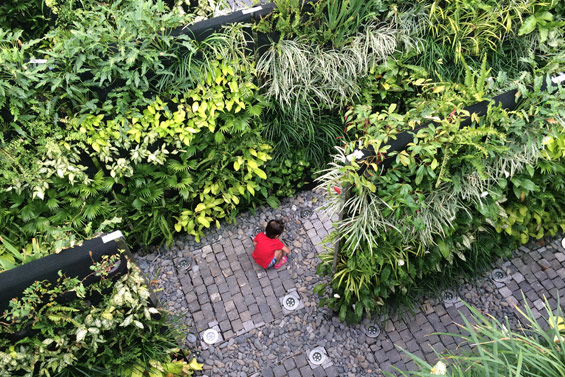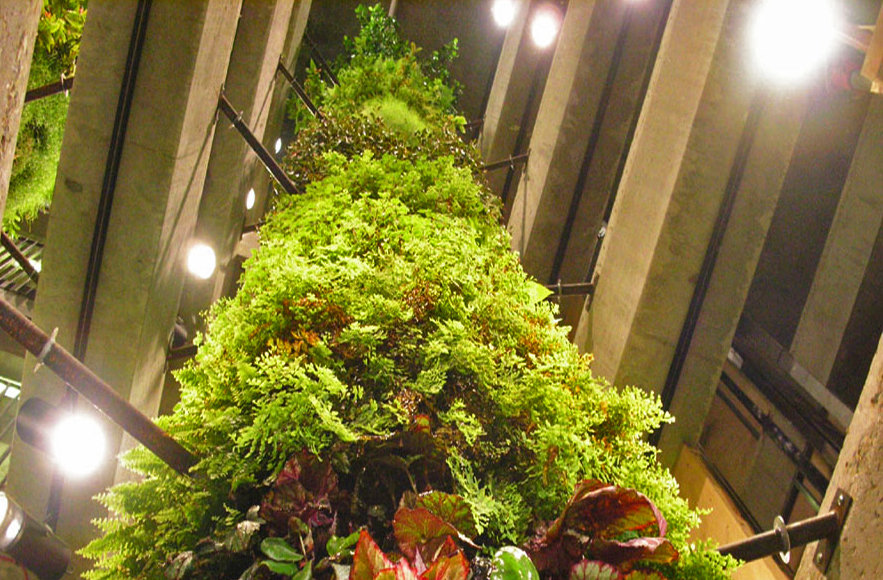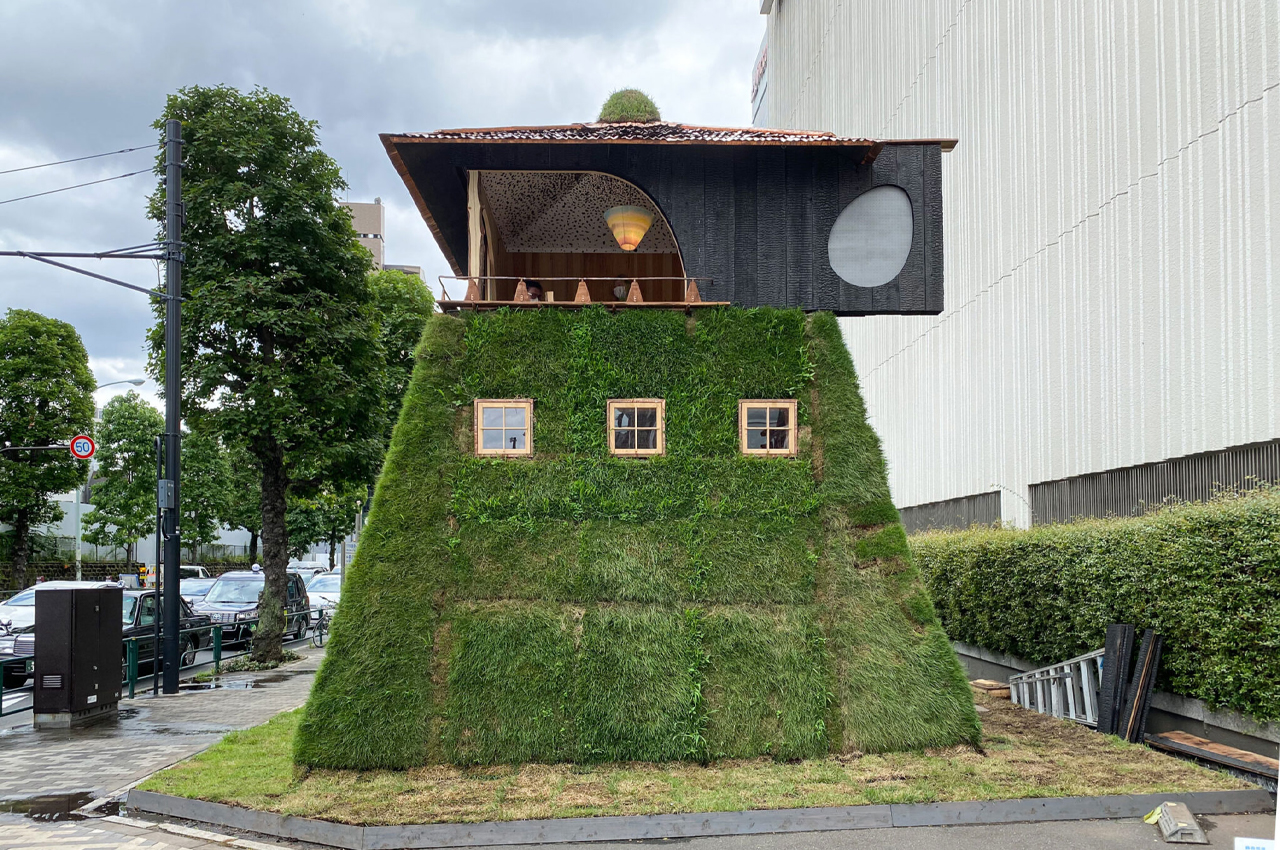Plants can be grown in inventive systems in tight spaces, including walls, as green facades, and on roofs. All systems differ in terms of maintenance, type of planting, and price but provide similar benefits. Green building systems provide cooler microclimates in urban areas, improve local air quality, can often sustain plantings where other vegetation couldn’t be supported (e.g. large trees), and can mitigate stormwater runoff¹. The following section defines each typology, including general site considerations, illustrates case studies globally and locally, and provides a list of recommended plants. All systems should consider the following when deciding what and where to install a green system¹:
- Seasonal considerations and general climate
- Local environment
- Weight loading from wind force
- Drainage and stormwater discharge points
- Irrigation, including water collection and storage
- Existing structure including size of wall, slopes, and material quality
- Machinery access and material storage
Green walls
Green walls are vertical systems for the growth of plants, either freestanding or attatched to a wall, allowing high density and diversity of planting. They can be intensive in irrigation requirements – water can be irrigated but requires a monitoring plan to minimize nutrient buildup. Fertilizer is often required for these systems¹.
Design + management specification details¹:
- For fully hydroponic systems, 0.5-20 litres of irrigation required per square metre a day
- 25-30 plants per square metre can fit on a vertical surface
Green facades
Green facades are systems of climbing plants at different levels up the face of a building wall, window, or other visually permeable structure. These systems are often less intensive than green walls and integrate twining and/or tendril climbers, preferably on support systems to minimize damage to the buildings. Careful consideration is required for wind for plant attatchment, drainage requirements, and accessibility for maintenance for tall buildings¹. In-ground soils will not dry out as fast as roof plantings but should have proper water-holding capacity, adequate nutrient supply, and appropriate root volume for climbers; where soil volume is a limiting factor, structural soils can be installed under hard surfaces.
Design + management specification details¹:
- 300 mm minimum distance from wall for twining and tendril support systems
- Orient support cables diagonally to increase foliage density
- After 1-2 month, pruning required to encourage lateral shoots of climbers
- Use evergreen species to screen an ugly view or for privacy
Green roofs
Green roofs provide numerous benefits, from mitigating stormwater runoff, improving biodiversity, and reduce annual rooftop runoff from 29-58% in Vancouver². Dry summer periods in Vancouver require green roofs to utilize drought-tolerant plants such as Sedum species. Other benefits include:
- Heat mitigation: A regular roof in Toronto on a summer day reached 70C the same day that a membrane on a green roof remained 25C.
- Durability: the layers of soil and plants protect the roof membrane against ultraviolet radiation.
- Building Insulation: the thick layers of green roof provide ample insulation from outside heat and cold.
- Biodiversity value: Green roofs can be planted with species that serve as habitat and/or food sources for local wildlife.
- Mitigation for air pollution: Green roofs can act as a filter for fine airborne particles and gaseous pollutants as plants catch and sequester urban smog, ozone and other emissions.
- Noise pollution: green roofs can absorb sound and reduce urban noise.
- Fire prevention: depending on the species of planting material, the rock and vegetation layers of a green roof can possibly suppress fire danger.
Design + management specification details⁵ :
There are two types of green roofs:
- Extensive: Have thinner layers of substrate and planting making them relatively lightweight (within the range of normal roof weight).
- Intensive: Have thicker layers of substrate and planting making them more effective at water management, ecosystem services through more varied planting, and insulation but they have more serious weight and structural implications.
Design Considerations:
- Weight: Green roofs are heavy. Loading for extensive green-roof systems range from 80-150kg per square metre and intensive systems range from 300-1000kg.
- Roof slope: Planting on a slope leads to slippage of planting materials. Stabilization materials like grids or battens must be added to keep slipping of materials to allow roof pitches up to 7:12 (30 degrees).
- Wind: local wind factors must be considered when choosing planting and substrate materials. Wind can damage plants and blow away substrate.
- Irrigation: generally is not needed if the correct planting is chosen for the local climate, but irrigation can be installed in special circumstances.
Planting options depending on roof thickness:
The planting options for a green roof depend on the local climate conditions, the slope of the roof, and the depth of the growing substrate of the green roof system. In Canada both cold winters and long, dry summers will define which plants will thrive on a green roof.
- The thinnest substrates of 2-3cm will support simple sedums and mosses.
- 5-8cm will support more species of sedums, grasses and herbaceous plants.
- 10-20cm will support drought-tolerant perennials and grasses, tough subshrubs and turf grasses.
- 30-50cm will enable most perennials and shrubs to grow.
- 80-130cm will allow enough root space for trees to grow.
Irrigation:
- 31 mm of irrigation is required in July and 22 mm in August for Vancouver ²
Methods for planting:
- Direct seed sowing or hydroseeding is cost effective and appropriate for seeding turf or meadow grasses. This may take more time to establish the desired planting effect and may have more weeds.
- Directly planting plugs will allow for a greater variety of plant types in a more aesthetic way. Plugs of 2.5cm across and 3-5cm deep are ideal. These plugs are recommended to be bought at wholesale so they are more economic. For tight vegetation planting is usually 10 plugs per square metre. This is recommended for small scale roof planting because it is labour intensive and more expensive.
- Vegetation mats are pre-grown sheets of vegetation on a geotextile base so they can be rolled up, transported, and unrolled on a green roof.They will root into the roof substrate in 4-5 weeks. This is usually the most expensive planting option.
- “Spontaneous colonization” is allowing the substrate of a green roof to pick up plant seeds that will germinate on the roof by themselves. This is the most ecological solution because it allows plants that are naturally acclimatized to the green roof location to thrive there without need for human input.
Case studies
For more project inspiration, explore David Brenner’s California green wall design firm Habitat Horticulture. For more on local Metro Vancouver greenwalls, see this 2018 City Studio student project by Jennifer Kumph, Kaylee Royce, and Irene Feng.
Museum of Pietrarsa Green Wall | Napoli, Italy¹

Photo credit: Travel France Online
A-Mazing Vertical Garden | Da Nang City, Vietnam¹

Photo credit: Damian Holmes, 2014 via World Landscape Architecture
Parking Des Ternes | Paris, France³

Photo credit: Patrick Blanc
Grass House | Tokyo, Japan³

Photo credit: Shawn McNulty-Kowal, 2021
Vancouver Convention Centre | Vancouver, BC⁴
Recommended plantings
Plants selected for green systems must perform well in challenging conditions and avoid high toxicity, irritation, poisonous, or thorny traits. Plantings can range from groundcovers to large herbaceous species, shrubs, and trees but in general, planting growth form will differ on vertical surfaces than on a roof/ground. The following are recommended for Vancouver conditions and found locally in nurseries for green walls, roofs, and facade systems. More information can be found in Ed Snodgrass’s book The Green Roof Manual (2010) and Nat’s Nursery’s Liveroof plant mixes. Ed Snodgrass started North America’s first nursery to specialize in green roof plants and runs Emory Knoll Farms.
*= native to British Columbia ^= suitable for drought/drier conditions
| Planting typlogy | Recommended species for the Metro Vancouver region |
| Green roof |
|
| Outdoor Green wall |
|
| Green facade |
|
1. Tong, Jialin. Living Wall Jungle The Concrete 2. Design Media Publishing (UK), 2017. 280 pp.
2. Roehr, Daniel. and Kong, Yuewei. Runoff reduction effects of green roofs in Vancouver, BC, Kelowna, BC, and Shanghai, P.R. China. Canadian Water Resources Journal, 2010. 35:1, 53-68, DOI: 10.4296/cwrj3501053
3. Lambertini, Anna. Vertical Gardens – Bringing the City to Life. Thames & Hudson, 2008. 240 pp.
4. greenroofs.com. Vancouver Convention Centre West/Expansion Project. 2024.
5. Kingsbury, N., & Dunnett, N. (2004). Planting Green roofs and living walls. Timber Press.
